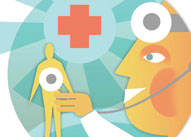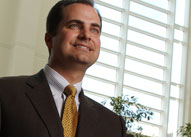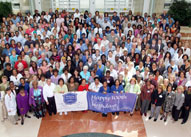

| Fall 2008 | ||||||||||||||||||
| Current Issue | ||||||||||||||||||
| Making better doctors Food fight One of them What our vision means for you Moving forward Clinical care From the Executive VP |
||||||||||||||||||
| Past Issues Other Publications Contact Us Make a Gift WHSC home |
||||||||||||||||||
|
||||||||||||||||||
The first trial tests an active vaccine, which uses part of the beta-amyloid protein. The Alzheimer’s vaccine is expected to stimulate antibody production. The study’s main purpose is to evaluate the vaccine’s safety, possible side effects, and how well it stimulates the immune system.
“Harnessing the patient’s own immune system may make it possible for us to change the course of the disease, rather than simply treat its symptoms,” says Allan Levey, Emory’s chair of neurology, who is leading the study.
Previous research on mice genetically engineered to develop a condition that resembles Alzheimer’s found that vaccination with beta-amyloid early in life protected the mice from plaque formation and mental decline. Older mice also showed some benefit from vaccination.
Accumulation of beta-amyloid appears to have negative effects that are unique to humans, says researcher Lary Walker at the Yerkes National Primate Research Center. Beta-amyloid is normally present in animals, although its function remains unclear. Beta-amyloid even forms plaques in older monkeys, but they don’t seem to suffer the same consequences, Walker says.
An earlier clinical trial of a beta-amyloid vaccine in humans was halted because a small fraction—approximately 6% of the participants—developed brain inflammation. Despite the unacceptable safety profile of the vaccine, patients who developed antibodies against amyloid protein (about 20% of participants) appeared to benefit.
The new vaccine, developed by Merck, uses a smaller piece of the beta-amyloid protein. By using the smaller section of the protein, developers hope to avoid activating T cells, the shock troops in an inflammatory response.
Two additional trials at Emory are testing passive treatments for Alzheimer’s, where a vaccine is replaced with pre-made beta-amyloid antibodies either from human donors or genetically engineered particles that resemble human antibodies.
Although financial analysts have predicted that the antibody treatments could make billions of dollars if successful and approved by the FDA, Emory neurologist James Lah sounds a note of caution. “It is important to keep in mind that the previous immunotherapy studies failed,” he says. “These are first and foremost research studies that gather information.”
In related news, Elan and Wyeth announced preliminary results in June for a phase 2 clinical trial of an antibody against beta-amyloid called bapineuzumab. (Phase 3 trials are under way now.) The pharmaceutical companies believe that the antibody treatment helps some patients but only those who do not carry a particular form of the gene ApoE. This “bad” form of ApoE, dubbed ApoE4, is associated with an increased risk of developing Alzheimer’s disease. Geneticists estimate that non-carriers of ApoE4 make up 40% to 70% of the Alzheimer’s disease population.
The development of antibody treatments presents a challenge to people who have Alzheimer’s in their family. Until this year, genetic tests for ApoE were approved only for people with existing dementia, but the commercial availability of the tests is expanding. Lah advises people to forego testing if they are asymptomatic, considering the potentially devastating impact on one’s life outlook. Professional societies of geneticists also agree with that advice, but practice may shift as consumer choice increases and more people opt to open Pandora’s box. —Quinn Eastmann

| ny | tiny font | ny |
Vitamin D deficiency conjures up a Dickensian image of pale, malnourished children working in bleak factories. But today an expanding number of health researchers see vitamin D deficiency as an unrecognized epidemic of the 21st century. By some estimates, more than a third of healthy adults in the United States have inadequate amounts of vitamin D in their bodies.
Why? Blame a life spent indoors.
“Our ancestors were hunter-gatherers who spent most of their time outside,” says Emory neurologist Marian Evatt. “Compare that to people nowadays. We go from our offices to our cars to our homes. I know my kids spend less time outside than I did when I was growing up.”
The consequences of avoiding the sun are becoming clearer. Researchers are finding that vitamin D not only plays a role in bone formation but also that deficiency may contribute to Parkinson’s disease, cancers, and disorders of the immune system. Emory scientists are probing the role of vitamin D deficiency in diseases ranging from colon cancer to lung fibrosis.
At a recent meeting of the American Academy of Neurology, Evatt presented her team’s research on 100 patients with Parkinson’s disease. Their study was sparked by a finding reported in 2007 that areas of the brain most affected by Parkinson’s appeared to have receptors for vitamin D. The Emory study found that a majority of the Parkinson’s patients who participated showed deficient levels of vitamin D—significantly more than Alzheimer’s patients or healthy people. Evatt’s team sees the results as striking, considering that their study group came from the sunny Southeast rather than a region with long winters, where vitamin D deficiency might be a bigger problem.
More recently, Evatt has begun a pilot study where Parkinson’s patients are given large doses of vitamin D. She is investigating whether the increased dose will restore deficient levels of the vitamin in their bodies and possibly address their neurologic symptoms.
Only a few foods in nature contain substantial amounts of vitamin D, such as salmon and tuna. Most Americans get their doses through exposure to sunlight or by eating fortified foods, including milk and packaged cereals. People with dark skin or who live at high latitudes tend to need more vitamin D.
Emory endocrinologist Vin Tangpricha, who heads a laboratory dedicated to vitamin D research, recommends a supplement with at least 1,000 international units (IU) of vitamin D or 5-10 minutes of sunlight daily. People with fair skin or a family history of skin cancer may want to limit that to a couple of minutes, he says.
Whether supplied in the diet or formed by ultraviolet rays reacting in the skin with a chemical relative of cholesterol, vitamin D still has to be converted to an active form by enzymes in the liver and kidney. It eventually travels into cells, where it binds to a receptor protein and helps turn on a variety of genes. In this respect, it acts similarly to estrogen and other steroid hormones.
Throughout most of the 20th century, doctors thought that vitamin D’s major role was forming strong bones by improving calcium absorption in the intestine, Evatt says. More recently, scientists have uncovered examples of its effects in other parts of the body, including the production of peptides that fight microbes in the skin, the regulation of blood pressure and insulin levels, and the stimulation of regeneration in the nervous system.
“In a way, it’s the hormonal equivalent of oxygen, because it’s hard to tease apart all of the effects of its absence,” Evatt says.
A question now facing vitamin D researchers is: how much is too much?
Tangpricha is tackling the challenge of delivering the vitamin to people who have a tough time absorbing it, such as those with cystic fibrosis and the elderly. He and his colleagues are comparing the effectiveness of tanning lamps vis-a-vis high doses of dietary supplements.
Both his preliminary results and Evatt’s studies indicate that people who lack vitamin D may benefit from very high doses, up to 10,000 IU per day. That’s the equivalent of 100 glasses of fortified milk or a half-cup of cod liver oil, an amount nutrition experts previously considered borderline toxic. —Quinn Eastman

Most health care systems tend to punish employees for making mistakes. And there are plenty of mistakes to punish. Research on the limits of human reliability shows that people who work in high stress environments, where dangerous activities are rapidly occurring, commit errors at a rate of up to 25%—despite the best of intentions. In the health care field, those mistakes translate into 50,000 to 100,000 deaths from medical errors each year.
“That’s like an airplane falling out of the sky every day,” says Hal Jones, director of quality support services for Emory Healthcare. “Even the lower estimate would make going to a hospital the eighth leading cause of death in the United States, exceeding motor vehicle accidents, breast cancer. and AIDS.”
Emory Healthcare finds that statistic unacceptable, and the system has embarked on an unusual approach to lowering fatalities, asking employees to admit mistakes to management, colleagues, and patients. And it is developing a new disclosure policy for doctors, nurses, residents, and health care teams to encourage that approach.
“We want to be honest about what we do,” Jones says. “And we want employees to have confidence that when a mistake is made, it’s an opportunity for all of us to learn and to improve.”
Developing a more transparent health care system will take time, says Jones. People are still afraid of being punished and of being sued. Moving to the shared vision of Emory Healthcare leadership requires nothing less than a change of culture.
Toward that end, leaders have identified five organizational attributes key to achieving this vision: 1) fair and just culture, 2) patient- and family-centered care, 3) transparency, 4) shared decision-making, and 5) cultural competency. For example, in the area of cultural competency, leaders want all members of Emory Healthcare teams to be fully aware of the effect of racial, economic, and education differences on how patients and their families respond to and participate in health care.
From the patient- and family-centered care perspective, they also want patients and families fully involved in health care decisions—what Jones calls a shift from “doing for patients and families” to “doing with patients and families.” Patients’ families will be encouraged to participate in health care to the extent that they choose. Old visiting hour rules will disappear, replaced by a model that invites families to be fully present with loved ones, staying at the bedside during procedures and even life-threatening situations.
It’s a logical move for the way medicine should be practiced today, Jones says. “In so many situations and from so many important perspectives, no one knows more about the patient than the family.” —Rhonda Mullen

| ny | tiny font | ny |
| With an engineering background focused on improving products and delivery at Ford, Peterson brings an industrial understanding of teamwork to his job as COO of Emory Crawford Long Hospital. | ||
Dane Peterson’s job as chief operating officer of emory crawford long hospital is pretty straightforward. No matter how good things already are at the midtown hospital, he is supposed to make them better.
For patients, better means a hospital ever more centered on their needs and those of their families and caregivers, a place where “we don’t do things to patients but with them,” says Peterson. For employees, that means creating “a fair and just culture,” where physicians and staff have confidence that we know everyone makes mistakes and that our first response when mistakes are made is going to be “what can we, together, learn from this,” not “who is at fault and who should be punished.” And for neighbors in the community surrounding the hospital, better refers to expanded health services for intown workers and dwellers and the hospital’s help in efforts to make midtown be—and feel—accessible and safe. Already a major employer in the area, the hospital will only increase its impact in light of Emory’s plans for new clinical and research space on the midtown campus.
Peterson comes to this anything-but-simple job well prepared. Most recently, he was associate administrator, then interim COO, of Medical City Dallas Hospital, a 677-bed hospital owned by HCA. Trained as an industrial/operational engineer, with an MBA from Stanford, he first honed his skills for improving products and delivery in multiple engineering positions at Ford and other industrial organizations. When he made the switch to health care six years ago (“to work among mission-driven people,” he says), he brought an understanding that good things don’t get done unless they involve the whole operation. Also they must be spelled out in ways that can be understood, widely accepted, and measured, says Peterson.
The overriding “good thing” he sees in Emory Healthcare is an attention to quality. In COO parlance, that’s the degree to which activities increase the likelihood of desired health outcomes, patient safety, and customer service.
In Peterson’s first nine months on the job, beginning in December 2007, here’s a glimpse of how he’s helping boost that quality.
• a focus on the “big four:” patient satisfaction, physician satisfaction, employee engagement, and financials built on growth opportunities that will be here today and tomorrow. Surveys are under way in some of those areas. He is also looking for ways to reinvest in the hospital leaders, what he calls “sharpening the saw.”
• issues discussions with physicians. How to improve start time for the first case in the operating room. How to better handle diversions, when the number of patients needing emergency service exceeds capacity at Atlanta hospitals. He listens, prioritizes issues, and communicates timetables.
• making employees’ jobs easier and more fulfilling. Sometimes that means a pat on the back. Often it means making it easy to do the right thing. A nurse who is struggling with a piece of tubing has less time to focus on a patient who may be giving off a nonverbal signal that something is not right. Creating systems and processes to avoid such distractions (and chances for errors) and making sure that the hospital has the right resources in the right place to handle the needs for every patient is sometimes easier, however, than building more time for interactions with patients and families into staffing budgets. “We won’t get there in a day,” says Peterson, “but we will get there.”
Peterson was drawn to Emory Crawford Long because of its mixture of private and academic physicians, a structure that “makes any operational improvements here applicable to the majority of the nation’s 4,500 hospitals,” he says. He loves the hospital’s interaction with residents, students, and researchers from Emory’s schools of medicine, nursing, and public health. His eyes also light up when he discusses the biomedical partnership between Emory and Georgia Tech, one that is expected to strengthen with the addition of new research space on the midtown campus.
This year, Emory Crawford Long Hospital celebrates its 100th birthday with historical exhibits (from a wooden stethoscope to a Y2K survival guide), tours, and other activities. Given the ambitious goals for the hospital’s second century, Peterson may not play golf as much he once did, but today he finds bigger rewards in the day-to-day job. He is helping create an environment that will improve care for patients and make everyone associated with the hospital proud. The job will take more than a day. —Sylvia Wrobel

Established in 1908, Emory Crawford Long Hospital opened with 26 beds in downtown Atlanta. These 100 years later, the hospital has grown to a 511-bed, community-based, acute care teaching facility,
admitting nearly 23,000 patients in 2007 and employing more than 2,700 staff. For a full history, visit www.whsc.emory.edu/multimedia_eclh_100.
Current Issue | Past Issues | Contact Us | Make a Gift
Back to Top | WHSC home
© 2008. Emory University, All rights reserved.
Back to Top | WHSC home
© 2008. Emory University, All rights reserved.